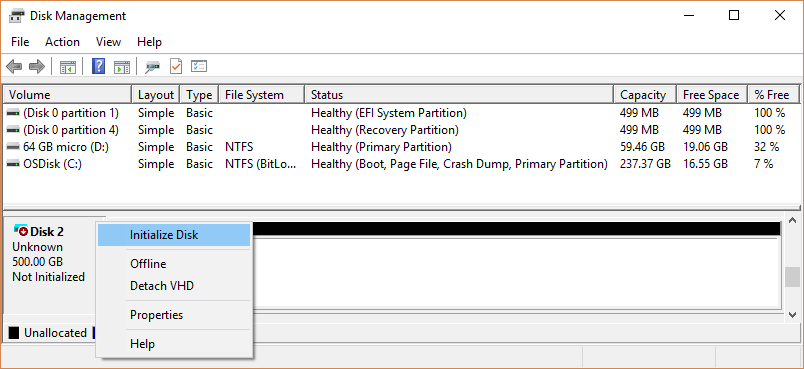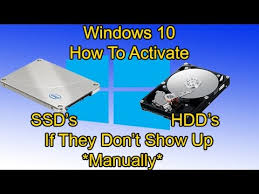Ssd Not Showing Up In Windows 10
- Ssd Not Showing Up In Disk Management
- Ssd Not Showing Up In Windows 10 1
- Ssd Not Showing Up In Windows 10 2016
The Most Common Reason Your Disk Is MissingYou grabbed a nice big hard disk on sale, you cracked open your computer case, plugged the drive into the motherboard and power supply with the appropriate cables (no? Better double check that before you keep reading), and when you booted your computer back up the new hard drive was nowhere to be found.RELATED:Or maybe you followed along with and can’t figure out why, even though you can hear the disk whirring away in the enclosure, you don’t see the disk in Windows. What’s the deal?Unlike the hard drive that ships with an off-the-shelf computer or external drive, extra hard drives you purchase aren’t always shipped formatted and ready to use. Instead, they’re in a totally blank state–the idea is that the end user will do what they wish with the drive, so there is no benefit to preformatting or otherwise changing the drive at the factory.As such, when you put the drive in your system, Windows simply waits for you to decide what to do with the drive instead of automatically formatting and adding it to the drive list. If you’ve never added a hard drive to your computer before, however, it can be pretty disconcerting when it appears like the drive is missing (or, worse, dead). Have no fear, though!

It’s easy to bring your hard drive out of hiding. How to Bring Your Missing Drive OnlineAssuming that the hard drive is installed properly, and is not, (by some horrible dumb luck) defective out of the gate, bringing it online is a very simple process. To do so, you first need to pull up the Windows Disk Management tool.Press Windows+R on your keyboard to launch the Run dialog box. Type diskmgmt.msc into the box and press Enter.Before we proceed, we want to appropriately scare you: Do not play around in Disk Management. Although the task we’re about to perform is very straightforward and simple to do, if you muck around with this tool you will have a very bad time.
Double check every step. Make sure you’re selecting the correct disk, or you can lose lots of data. Below.In Disk Management, scroll down through the list of disks in the bottom pane.
Ssd Not Showing Up In Disk Management


Ssd Not Showing Up In Windows 10 1
These disks will be labeled “Disk 1” through however many disks you have. Windows assigns a number to all hard disks, solid state disks, USB drives, and card readers, so don’t be surprised if you have to scroll down a bit–in our case the new drive was “Disk 10” as seen below.There are four bits of information here that indicate we’re looking at the right disk. First, the disk is marked as “unknown” and “Not initialized” on the left, which a brand new disk introduced to the system would be flagged as. Second, the drive size matches the size of the drive we just installed (around 1 TB), and the drive is flagged as “unallocated”, which means none of the hard drive space has been formatted or assigned a partition.Right click on the name portion of the disk entry, where it says “Disk #”, and select “Initialize Disk” from the right-click context menu.RELATED:In the first step of the initilization process, you’ll be prompted to choose whether you want to use a Master Boot Record (MBR) or a GUID Partition Table (GPT) for the partition style of your disk. If you want to do some in depth reading before making a choice, you can. In short, unless you have a pressing reason to use MBR, use GPT instead–it’s newer, more efficient, and offers more robust protection against corruptions of the boot record.Click “OK” and you’ll be returned to the main Disk Management window.
There you’ll find that your disk is now labeled “Basic” and “Online” on the left, but the contents are still “unallocated”. Right click on the striped box presenting the unallocated drive space. Select “New Simple Volume”.This will launch the New Simple Volume Wizard to guide you through the process of setting up the disk. In the first step, select how much space you want to include in the volume. By default the number is the full amount of available disk space–unless you’re planning on reserving space for additional partitions, there’s no reason to change this.
Samsung note 9 font support. Bixby improvementsLike the rest of the phone, Samsung’s homegrown A.I. Note 9 and users will also be able to get their hands on a special Galaxy-themed skin for their character too. Exclusive ‘Fortnite’ betaOne of the world’s most popular video games is — but it’s Samsung who has snagged it first. The beta of Fortnite: Battle Royale‘s Android version will be available exclusively on Samsung’s smartphones (Galaxy S7 and newer) for 30 days from August 9, and a pre-order bundle of the Note 9 will come with $150 of V-Bucks for your Fortnite account.
Ssd Not Showing Up In Windows 10 2016
Click “Next”.In the second step, assign a drive letter. The default is probably fine.RELATED:Finally, format the volume. If you’re using the volume for routine computing tasks (storing photos, video games, etc.) there’s no real need to deviate from the default NTFS file system and settings. Curious about the differences between file systems and why you might use the different options? Give your volume a name, click “Next”, and wait for the format process to finish.When the process is complete, you’ll see your new drive–allocated, formatted, and ready for action–in the Disk Management disk list.You can now use the disk like any other on your system for media storage, games, and other purposes.